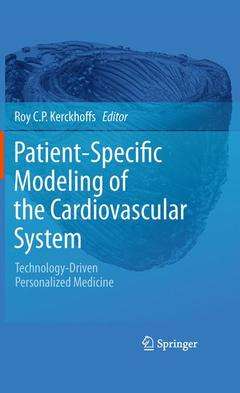Description
Patient-Specific Modeling of the Cardiovascular System, 2010
Technology-Driven Personalized Medicine
Coordinator: Kerckhoffs Roy C.P.
Language: English
Subjects for Patient-Specific Modeling of the Cardiovascular System:
Publication date: 10-2014
240 p. · 15.5x23.5 cm · Paperback
240 p. · 15.5x23.5 cm · Paperback
Description
/li>Contents
/li>Comment
/li>
Peter Hunter Computational physiology for the cardiovascular system is entering a new and exciting phase of clinical application. Biophysically based models of the human heart and circulation, based on patient-specific anatomy but also informed by po- lation atlases and incorporating a great deal of mechanistic understanding at the cell, tissue, and organ levels, offer the prospect of evidence-based diagnosis and treatment of cardiovascular disease. The clinical value of patient-specific modeling is well illustrated in application areas where model-based interpretation of clinical images allows a more precise analysis of disease processes than can otherwise be achieved. For example, Chap. 6 in this volume, by Speelman et al. , deals with the very difficult problem of trying to predict whether and when an abdominal aortic aneurysm might burst. This requires automated segmentation of the vascular geometry from magnetic re- nance images and finite element analysis of wall stress using large deformation elasticity theory applied to the geometric model created from the segmentation. The time-varying normal and shear stress acting on the arterial wall is estimated from the arterial pressure and flow distributions. Thrombus formation is identified as a potentially important contributor to changed material properties of the arterial wall. Understanding how the wall adapts and remodels its material properties in the face of changes in both the stress loading and blood constituents associated with infl- matory processes (IL6, CRP, MMPs, etc.
Integrating State-of-the-Art Computational Modeling with Clinical Practice: The Promise of Numerical Methods.- Patient-Specific Modeling of Cardiovascular Dynamics with a Major Role for Adaptation.- Patient-Specific Modeling of Structure and Function of Cardiac Cells.- Studies of Therapeutic Strategies for Atrial Fibrillation Based on a Biophysical Model of the Human Atria.- Patient-Specific Modeling for Critical Care.- Biomechanical Analysis of Abdominal Aortic Aneurysms.- The Cardiac Atlas Project: Towards a Map of the Heart.- In Vivo Myocardial Material Properties and Stress Distributions in Normal and Failing Human Hearts.- Modeling of Whole-Heart Electrophysiology and Mechanics: Toward Patient-Specific Simulations.- Personalized Computational Models of the Heart for Cardiac Resynchronization Therapy.- Patient-Specific Modeling of Hypoxic Response and Microvasculature Dynamics.- A Computational Framework for Patient-Specific Multi-Scale Cardiac Modeling.
First book to focus on patient-specific modeling of the heart
This book covers the design of a variety of patient-specific models within the cardiovascular system in computational biology
Focus on the potential of patient-specific computational models of cardiovascular physiology to predict or optimize outcomes of clinical treatments
Includes supplementary material: sn.pub/extras
© 2024 LAVOISIER S.A.S.




